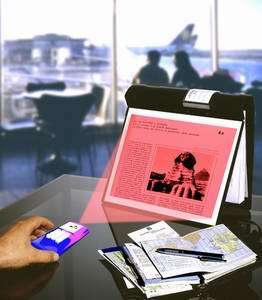Vest-pocket beamer

The vest-pocket projector could soon become reality. It is based on a tilting micromirror that builds up the picture line by line. The designers of a laboratory prototype have managed to raise its operating speed and resolution to the point where graphics and text are clearly legible.
The future beamer is likely to be no larger than a cube of sugar. Incorporated in a cell phone, the miniature projector would always be on hand – to present PowerPoint slides to a small group of customers or for quickly consulting an online journal. It could provide useful orientation in unfamiliar towns by projecting a street map onto the wall of the nearest building. This may be fantasy, but researchers at the Fraunhofer Institute for Silicon Technology ISIT have already built a demonstrator for a device of this size. It is capable of projecting text and images at a resolution of 320 by 240 pixels. Its chief component is a tilting mirror measuring 1.5 millimeters in diameter, which can be mass-produced on a microchip. The mirror deflects a laser beam by rapidly switching its angle of orientation, building up the picture pixel by pixel.
“The special feature of this mirror is the way it is mounted,” relates Ulrich Hofmann. “It is held by two torsion springs that allow the mirror to be tipped around two axes, in order to deflect the laser beam both horizontally and vertically.” Each time the mirror is moved, the springs pull it back to its original position so quickly that the movement can be repeated, in different directions, several thousand times per second. The electronics have been speeded up to match this high switching frequency. The control circuits take mere nanoseconds to decide how the laser light must be modulated in order to display each pixel with the right brightness. To avoid projection errors, the laser diode is backed up by a duplicate. It directs its beam at the mirror, but the light is reflected back to a photodiode that senses the mirror’s angle of orientation. “If, for instance, the mirror is knocked out of position by unexpected vibrations, the backup laser notices this,” explains Hofmann. “The electronics can then respond by adapting the projection data accordingly.” This feature makes the system insensitive to most external sources of interference.
The demonstrator is still too bulky to fit inside a cell phone. “When we did our tests, the electronics had not yet been miniaturized to that extent,” the physisist says. But that is one of the researchers’ next objectives, alongside increasing the mirror’s switching speed and hence the resolution. Another problem that remains to be resolved is the light source: At present, the only available laser diodes of sufficient durability and brightness all emit red light. Here, the researchers are waiting for their colleagues to find a solution. But their system is already designed to operate with multicolor diodes.
Source: Fraunhofer-Gesellschaft


















